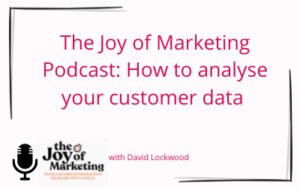Many surprising things happened in the world of retail in the last few years. A real eye opener for multi-channel retailers was the speed that previously reluctant older customers took to shopping regularly online, with the number of over 55s trebling this year alone.
Despite previous perceptions about targeting an older demographic online, the investment is now paying off for many, with multi-channel retailer Chums reporting a 175% increase in mobile traffic from this age range.
At Tapestry, we work closely with several brands that serve the mature market, and we see the trend towards online continuing. The familiarity and positive experience of purchasing online during the lockdowns means a large proportion of older customers now combine online and in-store shopping.
So as mature customers engage more online, how can multi-channel retailers retain engagement across their preferred channels to keep them coming back for more in 2022?
1. Older customers shop with brands they trust
While millennials and younger shoppers will buy on impulse, mature customers prefer to build trust in a brand over time. Often having more time to research their purchases, and higher levels of disposable cash, they want to spend wisely. Therefore, marketers should look to capture their attention with organic search and brand paid search, if they’re not doing so already.
Mature customers also value reviews and recommendations, so it’s a good idea to encourage customers (of all ages) to leave their stories and reviews. Nurture campaigns – i.e. structured, timely emails that talk about the brand and its values, offer updates and provide a strong call to action – are also a good way of keeping up momentum when it comes to engagement.
2. Safety online is a prime concern
For the over 60s particularly, a lack of confidence in online safety impacts their willingness to embrace ecommerce. And this goes hand in hand with building trust in your brand. Reassure customers about your security systems, make the purchasing process easy, provide clear instructions, and check that your whole website infrastructure (e.g. point of sale system, encryption technology and fraud detection) is geared towards protecting purchasers.
3. Mature customers are using more devices, more often
As our Insight Director David Lockwood observes in a Retail Commerce Discussion about meeting the needs of the over-50s consumer, opportunities to engage this cohort online are multiplying now that they are buying new devices and embracing shopping on their mobiles. Habits that were once the preserve of millennials, such as scrolling through a phone while watching TV, are being adopted by older people, too.
As mature customers embrace more channels, brands should grasp the opportunity to feed their messages into multiple outlets at once, amplifying the impact of their marketing effort. But this is no time to ditch offline marketing activities, such as catalogue mailings and in-store promotions. Using print alongside digital will be the most effective way to drive response. Similarly, invest in multi-pronged approaches that engage audiences both when they are actively searching and when they are in leisure mode.
4. Social media has been a lifeline
During the lockdowns social platforms served as a support channel for older generations like never before. Facebook remains their favourite, with 46% of over 65s, and 68% of those aged 55-64, using it regularly. YouTube is popular too, with over 55s watching an average of 22 minutes of video every day.
However, ‘younger’ platforms such as Pinterest and Instagram have received a deluge of older followers, so marketers need to build campaigns that attract older customers across all existing social platforms. Our recent research for a client with a strong older customer base revealed a much higher than anticipated ROI for their paid social campaigns.
Keep an eye on how social platforms evolve and be prepared to add new ones into the mix. Pinterest is working on improvements to its marketing features, and some of the more traditional brands are jumping onto TikTok at pace. Look out, too, for Instagram Reels, which may soon develop into a platform with the potential to showcase a brand’s personality in ways that appeal to older consumers.
5. The personal approach is powerful
When it comes to customer service, mature shoppers prefer speaking to a real person (not a chatbot). Our clients’ customer data shows that higher conversion rates and order values result from campaigns that encourage customers to call a sales line. Just make sure the phone number is visible on each landing page and in every email, display ad and piece of printed collateral.
Explainer videos, using real people and offering product demonstrations, also add the human touch. That’s why QVC is often effective, and it’s a compelling reason to think about creating helpful videos around your products. Making these age-appropriate will help to ensure they are engaging. As Woman & Home’s Executive Editor, Miranda McMinn, notes, using photos of older individuals elicits more powerful, positive responses.
Here at Tapestry, we work with several clients with an older following, including Cosyfeet, Parsley Box, Cotton Traders, Lily Ella and Museum Selection, to help them understand changing customer behaviours, and measure the performance of their marketing strategies across channels. And one thing is clear – recent events have accelerated their adoption of new devices and platforms, whetted their appetite for fresh content, and given them impetus to try new experiences such as online shopping. Get in touch to find out how we can help you keep your more mature customers engaged today.




